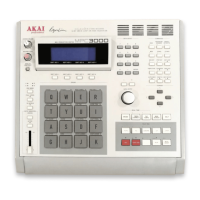Page 137
Chapter 7: The MIXER/EFFECTS Key
3. Rotate the data entry control. Turning it will rotate through ten
selections:
[-] The pad’s sound has no output assignment
1 The pad’s sound is sent to individual output 1
2 The pad’s sound is sent to individual output 2
3 The pad’s sound is sent to individual output 3
4 The pad’s sound is sent to individual output 4
5 The pad’s sound is sent to individual output 5
6 The pad’s sound is sent to individual output 6
7 The pad’s sound is sent to individual output 7
8 The pad’s sound is sent to individual output 8
E The pad’s sound is sent to the internal effects
generator
If the sound being adjusted is a stereo sound, then the available
selections are different:
[-] The pad’s sound has no output assignment
[ ] The left side of the sound is sent to individual output
1 and the right side is sent to individual output 2
[ ] The left side of the sound is sent to individual output
3 and the right side is sent to individual output 4
[ ] The left side of the sound is sent to individual output
5 and the right side is sent to individual output 6
[ ] The left side of the sound is sent to individual output
7 and the right side is sent to individual output 8
[E] Both sides of the sound are sent to the internal
effects generator
Notice that the screen displays pad numbers, yet the mixer contains
data for each of the 64 note number assignments (35-98) in the
active program. For each pad number on the screen, the data shown
is from the note number (35-98) within the active program to which
the pad number is currently assigned (in the MIDI key, option 1
screen). If you want to be able to adjust mix data by selecting a
specific note number regardless of its pad assignment, use the All
Mix Data (Text) function, accessed by selecting option 3 from the
initial MIXER/EFFECTS key menu.
COMMENT: The data values used for this mixer are nor-
mally taken from the active program. Because of this, when-
ever the active program is changed, the newly selected
program’s individual output assign and mix settings will
immediately become active. However, it is also possible to use
settings from the active sequence so that each newly selected
sequence will have its own custom settings, or to use a single
master set of individual out assignments and mix data so
that the settings never change when either the program or
sequence is changed. This choice may be made in the Mixer
Source Select fields, accessed by pressing option 4 from the
MIXER/EFFECTS key menu.

